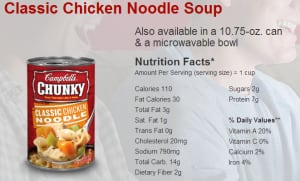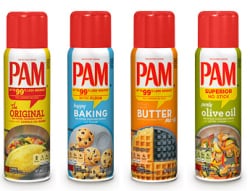In comments to the agency about the proposals, the Rudd Center for Food Policy and Obesity says it supports moves to revise the Reference Amounts Customarily Consumed (RACCs) for foods such as ice cream and bagels to facilitate more realistic serving sizes, but urges it to look again at several other products as well…
Canned soup: A ‘dramatic example of the current unrealistic serving sizes’
The first category it urges FDA to tackle is canned soup, which “presents a dramatic example of the current unrealistic serving sizes,” claims the center, a non-profit research and public policy organization based at Yale University.
“The Nutrition Facts label for Campbell’s Chunky Classic Chicken Noodle soup lists a 1-cup serving size (less than one-half of an 18.6 ounce can) that has 790mg of sodium. However, a 2011 national telephone survey conducted by the CSPI found that 64% of consumers eat an entire can of such a soup at one time.
“Compared to the 1993 RACC for soup (245g), the median consumption of soup in 2003-2008 was 316g, a 29% increase. Yet, no change in RACC was proposed for this food product.

"FDA’s proposal that containers up to two times the RACC would have to be labeled as single servings would not cover soups like Campbell’s Chunky or condensed lines.”
Powdered coffee creamers: 2g is not a realistic serving size …
The next category it wants the agency to look at is powdered coffee creamers, which have a 2g RACC (serving size: oneteaspoon). But NHANES data shows that the median intake doubled from 2g in 1993 to 4g in 2003-8, without a corresponding change to the RACC, says the center.
“Many consumers pour more than 2g into their coffee because they believe that the creamer is fat-free at any serving size.”
In reality, these products do contain fat, but at a 2g serving size, they typically contain less than 0.5g fat per serving, which means that they are allowed to state ‘0g fat’ on product labels, says the center. Were the serving size to increase, consumers would see how much fat/calories they are really getting, it says.
“In order for people to get a more accurate idea of the calories and saturated fat they consume from powdered coffee creamers, we recommend that the FDA modify the RACC to reflect a more realistic serving size, such as one tablespoon, the serving size for liquid creamers.”
Aerosol cooking sprays: Serving sizes are ‘tiny’

Similarly, aerosol cooking sprays such as PAM have “tiny serving sizes”, and as a result, are legally permitted to make zero calorie and zero fat claims, even though their first ingredient is oil, notes the center.
“The FDA should propose to increase the existing RACC for 'fats and oils, spray types', currently set at 0.25g, to reflect a more realistic serving size based on consumer experience with sprays.”
For example, some of PAM’s labels disclose that a one-second spray contains 9 calories and 1 gram of fat, it says.
Cereals: Consumers typically consume more than the standard service size, in some cases eating twice as much
Next, the center urges the FDA to increase the standard serving size for cereal from 30g to 45g.

It adds: “Children and adults typically consume more than the standard service size, in some cases eating twice as much, and therefore doubling their sugar intake in a single sitting.
"The serving sizes are also inconsistent on packaging. For example, General Mills and Kellogg sell ‘single-serving’ cups of cereal that have 1.3 ounces in them, whereas the serving size on the large package is one ounce.”
Larger serving sizes would impact food marketing to kids
Changing cereal serving sizes would also impact food marketing and advertising to kids, it claims, noting that the Children's Food and Beverage Advertising Initiative standard (to which all the big cereal companies adhere) limits advertising to cereals that contain no more than 10g of total sugar per serving.
If the FDA were to increase the serving size for medium-dense cereals, it says, “fewer sugary cereals would meet those criteria, and hopefully, fewer would be marketed to children or companies would have to reduce the sugar content of popular cereals marketed to children.”
Pasta with sauce: RACC should be increased by 50%
Finally, it looks at pasta and sauce dishes. Compared to the 1993 RACC of one cup, Americans are now consuming a median of 1.5 cups of pasta with sauce, notes the center, which urges the FDA modify the RACC to reflect this.
The FDA says it may modify RACCs for products if the latest dietary intake data shows that median consumption has increased or decreased by at least 25%, compared to 1993, although it will also consider other factors (click HERE).
Click HERE for a summary of the proposed changes to the Nutrition Facts panel and stakeholder reaction.
